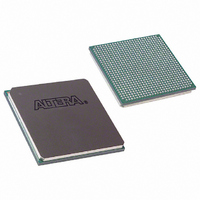EP1S20F780I6N Altera, EP1S20F780I6N Datasheet - Page 847

EP1S20F780I6N
Manufacturer Part Number
EP1S20F780I6N
Description
IC STRATIX FPGA 20K LE 780-FBGA
Manufacturer
Altera
Series
Stratix®r
Specifications of EP1S20F780I6N
Number Of Logic Elements/cells
18460
Number Of Labs/clbs
1846
Total Ram Bits
1669248
Number Of I /o
586
Voltage - Supply
1.425 V ~ 1.575 V
Mounting Type
Surface Mount
Operating Temperature
-40°C ~ 100°C
Package / Case
780-FBGA
Family Name
Stratix
Number Of Logic Blocks/elements
18460
# I/os (max)
586
Frequency (max)
450.05MHz
Process Technology
0.13um (CMOS)
Operating Supply Voltage (typ)
1.5V
Logic Cells
18460
Ram Bits
1669248
Operating Supply Voltage (min)
1.425V
Operating Supply Voltage (max)
1.575V
Operating Temp Range
-40C to 100C
Operating Temperature Classification
Industrial
Mounting
Surface Mount
Pin Count
780
Package Type
FC-FBGA
Lead Free Status / RoHS Status
Lead free / RoHS Compliant
Number Of Gates
-
Lead Free Status / Rohs Status
Compliant
Available stocks
Company
Part Number
Manufacturer
Quantity
Price
Company:
Part Number:
EP1S20F780I6N
Manufacturer:
ALTERA
Quantity:
3 000
- Current page: 847 of 864
- Download datasheet (11Mb)
Figure 14–4. Adjustable-Output Linear Regulator
Altera Corporation
January 2005
V
IN
+
C
1
IN
Linear Regulator
I
ADJ
Switching Voltage Regulators
Step-down switching regulators can provide 3.3-V-to-1.5-V conversion
with up to 95% efficiencies. This high efficiency comes from minimizing
quiescent current, using a low-resistance power MOSFET switch, and, in
higher-current applications, using a synchronous switch to reduce diode
losses.
Switching regulators supply power by pulsing the output voltage and
current to the load.
of switching regulators compared to linear regulators. For more
information on switching regulators, see Application Note 35: Step Down
Switching Regulators from Linear Technology.
There are two types of switching regulators, asynchronous and
synchronous. Asynchronous switching regulators have one field effect
transistor (FET) and a diode to provide the current path while the FET is
off (see
Highly efficient (typically >80%)
Reduced power dissipation
Smaller heat sink requirements
Wider input voltage range
High power density
ADJ
Table 14–4. Switching Regulator Advantages & Disadvantages
Figure
OUT
Advantages
14–5).
V
Table 14–4
REF
R
R
1
2
+
shows the advantages and disadvantages
C
2
V
Generates EMI
Complex to design
Requires 15 or more supporting
components
Higher cost
Requires more board space
OUT
Stratix Device Handbook, Volume 2
= [V
REF
Designing with 1.5-V Devices
× (1 +
Disadvantages
R
R
1
2
)] + (I
ADJ
× R
1
)
14–7
Related parts for EP1S20F780I6N
Image
Part Number
Description
Manufacturer
Datasheet
Request
R

Part Number:
Description:
CYCLONE II STARTER KIT EP2C20N
Manufacturer:
Altera
Datasheet:

Part Number:
Description:
CPLD, EP610 Family, ECMOS Process, 300 Gates, 16 Macro Cells, 16 Reg., 16 User I/Os, 5V Supply, 35 Speed Grade, 24DIP
Manufacturer:
Altera Corporation
Datasheet:

Part Number:
Description:
CPLD, EP610 Family, ECMOS Process, 300 Gates, 16 Macro Cells, 16 Reg., 16 User I/Os, 5V Supply, 15 Speed Grade, 24DIP
Manufacturer:
Altera Corporation
Datasheet:

Part Number:
Description:
Manufacturer:
Altera Corporation
Datasheet:

Part Number:
Description:
CPLD, EP610 Family, ECMOS Process, 300 Gates, 16 Macro Cells, 16 Reg., 16 User I/Os, 5V Supply, 30 Speed Grade, 24DIP
Manufacturer:
Altera Corporation
Datasheet:

Part Number:
Description:
High-performance, low-power erasable programmable logic devices with 8 macrocells, 10ns
Manufacturer:
Altera Corporation
Datasheet:

Part Number:
Description:
High-performance, low-power erasable programmable logic devices with 8 macrocells, 7ns
Manufacturer:
Altera Corporation
Datasheet:

Part Number:
Description:
Classic EPLD
Manufacturer:
Altera Corporation
Datasheet:

Part Number:
Description:
High-performance, low-power erasable programmable logic devices with 8 macrocells, 10ns
Manufacturer:
Altera Corporation
Datasheet:

Part Number:
Description:
Manufacturer:
Altera Corporation
Datasheet:

Part Number:
Description:
Manufacturer:
Altera Corporation
Datasheet:

Part Number:
Description:
Manufacturer:
Altera Corporation
Datasheet:

Part Number:
Description:
CPLD, EP610 Family, ECMOS Process, 300 Gates, 16 Macro Cells, 16 Reg., 16 User I/Os, 5V Supply, 25 Speed Grade, 24DIP
Manufacturer:
Altera Corporation
Datasheet:












